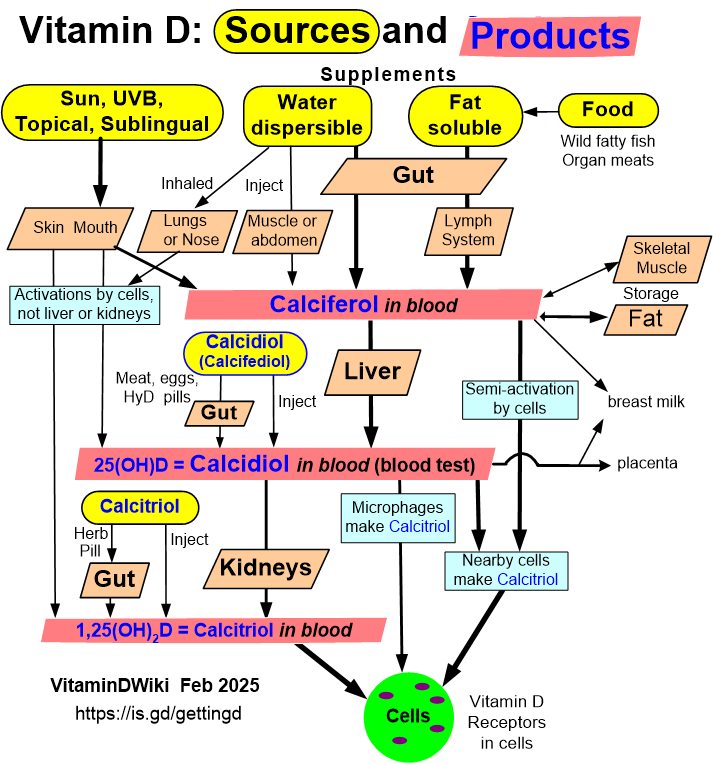6,400 IU of Vitamin D is safe and effective during breastfeeding – RCT Dec, 2020
Safety Aspects of a Randomized Clinical Trial of Maternal and Infant Vitamin D Supplementation by Feeding Type Through 7 Months Postpartum - Dec 2020
Breastfeeding Medicine VOL. 15, NO. 12 | 7 Dec 2020 https://doi.org/10.1089/bfm.2020.0056
Carol L. Wagner, Thomas C. Hulsey, Myla Ebeling, Judy R. Shary, Golaleh Asghari, Cynthia R. Howard, John E. Baatz, Danforth A. Newton, Amy E. Wahlquist, Susan G. Reed, Sarah N. Taylor, … See all authors
 Note: Calciferol is the source of Vitamin D in breastmilk
Note: Calciferol is the source of Vitamin D in breastmilk
📄 Download the PDF from sci-hub via VitaminDWiki
Background: The safety of higher dose vitamin D (vitD) supplementation in women who change from exclusive or full breastfeeding to combination feeding or who continue supplementation after cessation of breastfeeding is unknown.
Objective: Compare vitD supplementation safety of 6,400 to 400 IU/day and 2,400 IU/day using specific laboratory parameters in postpartum women and their infants through 7 months postpartum by feeding type.
Design: In this randomized controlled trial, mothers (exclusively breastfeeding or formula-feeding) were randomized at 4–6 weeks' postpartum to 400, 2,400, or 6,400 IU vitD3 (cholecalciferol)/day for 6 months. Breastfeeding infants in 400 IU group received oral 400 IU vitD3/day; infants in 2,400 and 6,400 IU groups received placebo. Maternal safety parameters (serum vitD, 25-hydroxy-vitamin D [25(OH)D; calcidiol], calcium, phosphorus, intact PTH; urinary calcium/creatinine ratios; and feeding type/changes) were measured monthly; infant parameters were measured at months 1, 4, and 7. Sufficiency was defined as 25(OH)D >50 nmol/L. Feeding type was defined as exclusive/full, combination, or formula-feeding. Data were analyzed using SAS 9.4.
Results: Four hundred nineteen mother-infant pairs were randomized into the three treatment groups and followed: 346 breastfeeding and 73 formula-feeding pairs. A dose of 6400 IU/day safely and significantly increased maternal vitD and 25(OH)D from baseline in all mothers regardless of feeding type (p < 0.0001) and was superior to the 400 and 2,400 IU groups in achieving vitD sufficiency with no other differences in safety parameters by treatment or feeding type. Infants in the 2,400 IU group were more likely vitD-deficient than the other groups; otherwise, there were no infant safety parameter differences.
Conclusions: While 6,400 IU/day was more effective than 400 or 2,400 IU/day in achieving maternal vitD sufficiency in all feeding groups, the groups did not differ on other safety parameters. Similarly, infant safety parameters did not differ by treatment group or feeding status.
Clinical Trial Registration: FDA IND Number: 66,346; ClinicalTrials.gov Number: NCT00412074.
Bone loss during breastfeeding reduced by 6,400 IU of vitamin D daily - June 2024
Factors Affecting Postpartum Bone Mineral Density in a Clinical Trial of Vitamin D Supplementation
J Womens Health (Larchmt) . 2024 Jun 10. doi: 10.1089/jwh.2022.0525 PDF behind paywall
Amy E Wahlquist 1 2, Harry H Blanke 3, Golaleh Asghari 4, John E Baatz 5, Myla Ebeling 5, Judy R Shary 5, Cynthia R Howard 6, Ruth A Lawrence 6, Bruce W Hollis 5, Carol L Wagner 5
Background: Few studies evaluate the effects of vitamin D status and supplementation on maternal bone mineral density (BMD) during lactation and further lack inclusion of diverse racial/ethnic groups, body mass index (BMI), or physical activity. Objective: Determine the effects of vitamin D treatment/status, feeding type, BMI, race/ethnicity, and physical activity on postpartum women's BMD to 7 months.
Methods: Women with singleton pregnancies beginning 4-6 weeks' postpartum were randomized into two treatment groups (400 or 6400 IU vitamin D/day). Participant hip, spine, femoral neck, and whole-body BMD using Dual-energy X-ray absorptiometry (DXA Hologic), serum 25-hydroxyvitamin D [2[5(OH)D] (RIA; Diasorin), BMI, and physical activity were measured at 1, 4, and 7 months postpartum. A general linear mixed modeling approach was undertaken to assess the effects of vitamin D status [both serum 25(OH)D concentrations and treatment groups], feeding type, race/ethnicity, BMI, and physical activity on BMD in postpartum women.
Results: During the 6-month study period, lactating women had 1-3% BMD loss in all regions compared with 1-3% gain in nonlactating women. Higher maternal BMI was associated with less bone loss in femoral neck and hip regions. Black American women had less BMD loss than White/Caucasian or Hispanic lactating women in spine and hip regions. Exclusively breastfeeding women in the 6400 IU vitamin D group had less femoral neck BMD loss than the 400 IU group at 4 months sustained to 7 months. Physical activity was associated with higher hip BMD.
Conclusion: While there was BMD loss during lactation to 7 months, the loss rate was less than previously reported, with notable racial/ethnic variation. Breastfeeding was associated with loss in BMD compared with formula-feeding women who gained BMD. Higher BMI and physical activity independently appeared to protect hip BMD, whereas higher vitamin D supplementation appeared protective against femoral neck BMD loss.
